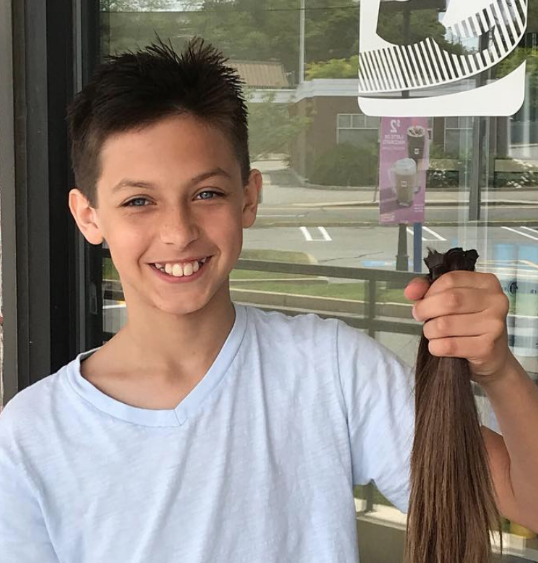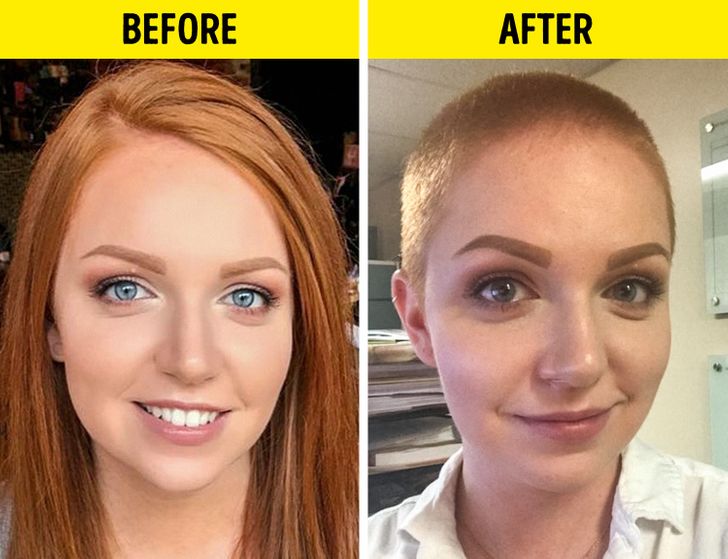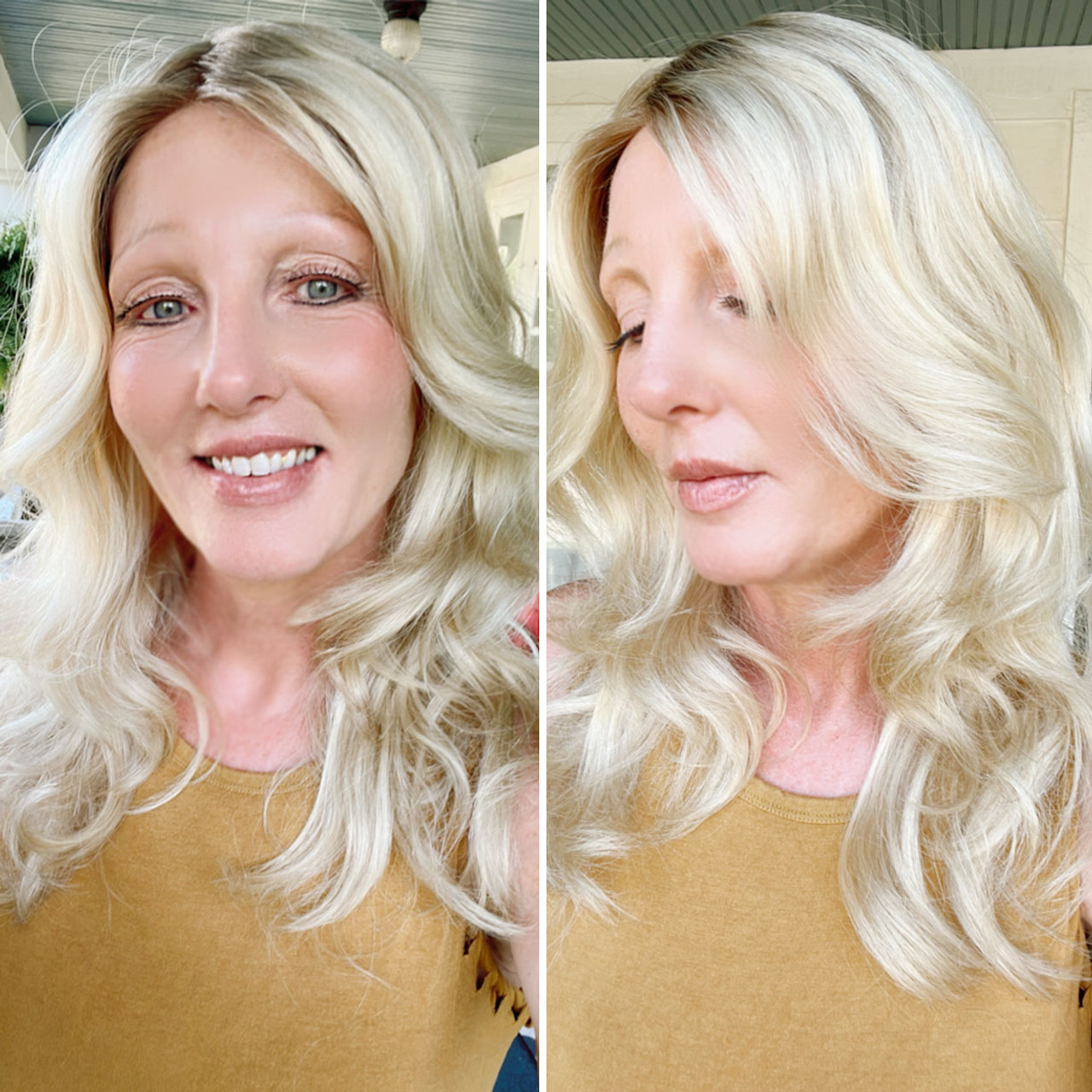Background Into:
As we all know, during cancer treatment, radiation therapy drugs are designed to attack cancer cells, which rapidly divide. The problem is that these drugs also affect other rapidly-dividing cells, such as hair follicles. The result, of course, is hair loss. As a result, many cancer patients have no choice but to shave their hair in order to relieve sufferings during radiotherapy.
Don't doubt your feelings about hair loss. You are cheerful that you are still alive, but that doesn't mean you can't feel bad about temporary hair loss. Hair loss can be a very painful process in the treatment of tumors. It is very normal to feel discouraged about it.
Maybe hair prosthesis can help give cancer patients some semblance of normalcy and make them feel and look like themselves, even for a few hours a day.
Related: Welcome To The Hair Loss Community—A Warm And Inviting Family

Three short stories:
Heute bin ich blond directed by Mark Rosman
Sophie Steppe, a twenty-one years old Dutch girl, was suddenly stricken with cancer. Because of chemotherapy, she became a bald girl. She bought nine synthetic hair wigs to dress up, originally just to escape from the truth, but accidentally in the "role-playing" to find a more real self, rediscovered the beauty of life. She's fragile, afraid of death and loneliness. She was also strong, looking at life's challenges with candor and ease. She went through the most difficult days in a whimsical, creative way.

A selfless little hero.
Aaron, a 10-year-old boy from England, has spent five years collecting his hair and donating wigs to cancer patients. He was ridiculed by others throughout his time wearing his hair long for the Little Princess Trust. His mother told him he could give up if he couldn't keep going, but Aaron said he couldn't stand by while thousands of kids are suffering from cancer. Finally, he raised £260 for the St. Panama Room Hospice.

"I want to be the same as before."
In 2019, 27-year-old Kapocha had a breast cancer surgery. The girl, who used to take care of her hair every month, went to the barber store and shaved her hair the day after her first chemotherapy treatment. She didn't shed a single tear when undergoing treatment, but instead cried her eyes out while her hair was being shaved. Since then, Kapocha has not dared to look herself in the mirror. It wasn't until Kapocha bought her first synthetic wig that looked exactly like her old hairstyle that she regained confidence to wear makeup again.

Prepare hair loss:
When shaving, use electric clippers instead of razors, and never clip down to your scalp. Leave one inch of length, especially for people with coarse or thick hair. If you clip your hair onto the scalp, the stiff hair will push back, and when you sleep on it or touch the sensitive scalp, it will make your scalp even more tender. Leave some length to allow your hair to hang down smoothly. During hair loss, you may find itchy hair everywhere on your pillow and clothes. Wearing a mesh hat can help you grab your hair strands.
If your goal is to make the wig match the color of your own hair, leave a strand of hair for your wig stylist to see. If possible, go to see a wig stylist before losing all your hair. Or at least take a photo of your hairstyle as a reference. To achieve the perfect transition, please choose a wig before starting chemotherapy, and then wait until the hair begins to become sparse before starting to wear it.
Related: How To Style Your Wig Like A Pro: Step-By-Step Tutorials
Even if your hair starts to regrow, you may still want to wear it. According to a 2019 study, most people experience hair regrowth around three months after completing cancer treatment and stop wearing wigs one year after chemotherapy. But some people will continue to wear wigs until their hair grows longer, or because their newly grown hair is different from pre-chemotherapy hair.
During chemotherapy, the scalp will become dry due to the cessation of oil secretion by the skin, so taking care of the scalp is very important. Support the health of your hair follicle so that on the day you stop all cancer treatment, your hair can start growing in large quantities without any obstacles.
Dry skin can hinder hair growth because these layers of dead skin cells can block the opening of hair follicles, making it difficult for new hair to break through the surface. Often use a soft brush or exfoliating gloves to exfoliate the scalp while showering. Facial cleansers or wash free care products containing salicylic acid can also help remove dry skin. Finally, use gentle conditioner to maintain moisture and minimize using hair straighteners or hair spray.
Related: Eco-Chic: Transform Your Haircare Routine With Sustainable Choices

Where to find a free wig:
The cost of cancer treatment is high, and patients often have very little money left over for cosmetic accessories and surgery. However, some national organizations are well aware of the impact of the appearance has on your spiritual status, and strive to provide cancer patients with a right wig free of charge.
National Health Service: In Wales, Scotland and Northern Ireland, cancer patients are offered free wigs. National Health Service (NHS) will cover the cost of purchasing a synthetic wig for eligible cancer patients. If the patient is allergic to chemical fibers, NHS will bear the cost of a human hair wig. NHS also provides advice on how to apply makeup and do skin care maintenance for cancer patients.
Angel Hair for Kids: it is a program of the A Child's Voice Foundation, is aimed at providing wigs for economically disadvantaged children in Canada who have lost their hair due to illness or chemotherapy. The foundation uses hair donated to the program to make wigs, which are provided free of charge to children in need. Every recipient of Angel Hair for Kids will receive a personal appointment at a wig bank. Wig specialists will guide children and their families in choosing the wig that best meets their needs.
Children with Hair Loss: Children's Hair Loss Organization (CWHL) is a non-profit organization dedicated to providing hair replacement resources for disadvantaged children with drug-induced hair loss caused by diseases such as cancer or burns. Children must be under 21 years old, hold proof of their date of birth and provide documentation to prove that their hair loss is caused by medical reasons.
American Cancer Society: It is a nationwide non-profit organization dedicated to eliminating cancer. They are volunteer and donated wigs based, striving to provide support for cancer patients. Here, you will be guided to the wig banks in your area or receive a gift coupon so that you can order real hair wigs through TLC, a non-profit organization that specializes in selling low-priced synthetic wigs.

Additional places you can seek for help:
Local cancer support groups: Even if a local cancer support group does not provide free wigs, their staff can tell you which groups in the area offer such services.
Wig shops: A wig shop may offer free wigs. Even if not, they might know someone who is providing this service, so they can point you in the right direction.
Salon owners: Hair salon owners usually have industry contacts who can quickly obtain information about wig stores and some cheap wig resources available to cancer patients.
Insurance companies: If you have health insurance, please consult your healthcare provider to check to see if your benefits include the cost of cranial prosthesis. If not included, please inquire if your insurance company can refer you to free wig stores.
Choose a medical wig:
Cancer patients need to wear wigs for a longer period of time after losing their own hair due to cancer treatments. If your financial condition permits, choosing a suitable medical wig can bring more confidence to your journey against cancer.

What is a medical wig:
Medical wigs are designed specifically for patients who lose their natural hair due to cancer treatment, alopecia, and other diseases. Most medical wigs are made of 100% human hair. Compared to other wigs, medical wigs have a very natural appearance that matches the patient's face shape and skin condition.

Features of a medical wig:
(1) Antibacterial mesh cap
Advantages:
- Professionally antimicrobial
- Safe and reliable
- Comfortable and durable
Tips: Antibacterial performance should meet the national standard.
(2) Hand-woven craft
Advantages:
- Breathable and lightweight
- Natural-looking hair strands
Tips: Hand-woven craft is relatively expensive, and has higher requirements for the textures of the wig hair.
(3) 100% real human hair
Advantages:
- The most realistic and natural look
- Can be dyed, permed and blow-dried
- Durable and long-lasting
Tips: The price of 100% it is high, but it can best meet the pursuit of a natural-looking wig of the anti-cancer people.

How to choose a medical wig:
If you plan to use wigs to cover up chemotherapy induced hair loss, then you should broaden your understanding of different types of wigs and learn how to choose the wig that suits you.
Match Your Current Hairstyle: When looking for a medical wig, you should choose a style that matches your current hairstyle. When consulting with hair loss experts, you can talk to them your specific requirements, and they will carefully make a free wig that perfectly matches your own hair.
Try a New Look: Many patients hope to achieve a brand new appearance. In this case, you should be very cautious in what style and color to choose. Please consult with a wig specialist privately to see what new styles are most suitable for your skin color and personality.
Learn about How to Care for the Wig: When wearing a medical wig, you need to pay attention to proper alignment. Wearing a wig is not difficult. However, you must know how to wear a wig in the right position. If aligning the wig correctly, you will create an extremely natural hairline.
Related: The Most Comprehensive Guide For Hair Toppers 101

Final Thoughts:
For many patients undergoing chemotherapy, anything that can help them rediscover themselves can make all the difference. It is not an exaggeration to say that a wig may change their life during treatment. If you're struggling with wig problems, try these measures. If you want to learn more about it, visit https://www.wigshe.com/blog, which will give you a lot of practical knowledge. We warmly welcome you!
Images credit: Instagram, Google, Pinterest.
